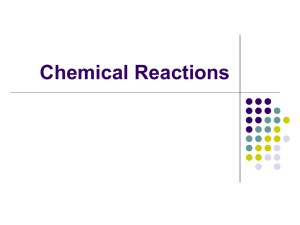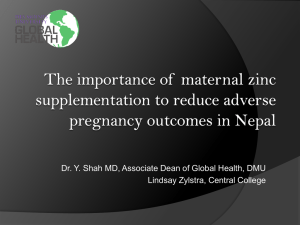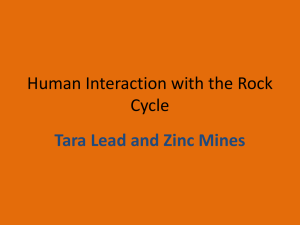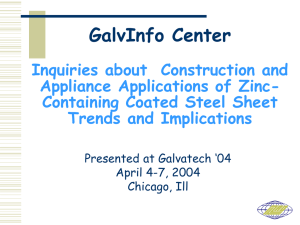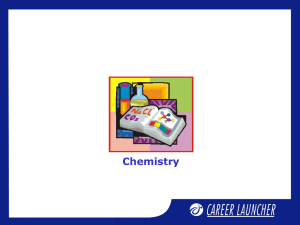Cooling Water Training
advertisement
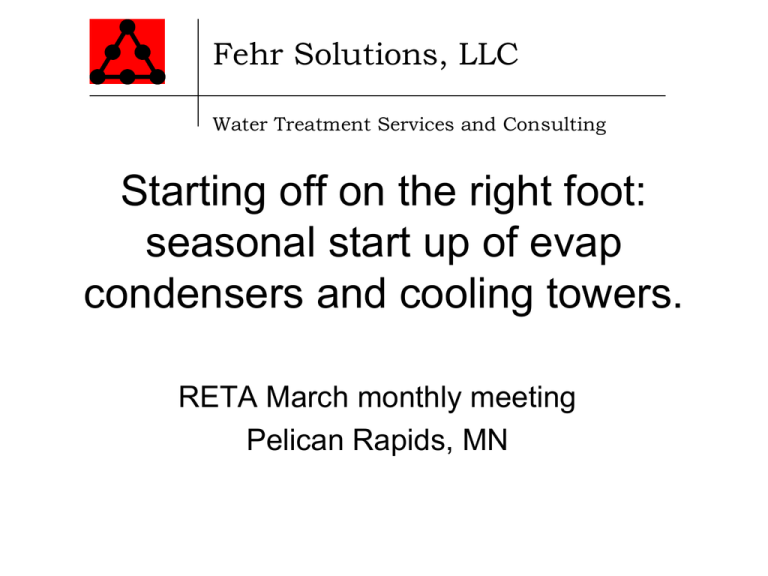
Fehr Solutions, LLC Water Treatment Services and Consulting Starting off on the right foot: seasonal start up of evap condensers and cooling towers. RETA March monthly meeting Pelican Rapids, MN Why do we have cooling/condensing towers • Help cool gaseous ammonia and make it easier to compress • To help cool water that is being used to pull heat from equipment or a process (ie chillers) • Improve cooling and refrigeration efficiency • >95 % of the cooling comes from water evaporation, not from the rise in the water temperature Evaporative Condenser Ammonia (or another compressible gas) is is cooled as water evaporates from the surface of the condenser coil Cooling tower Water is cooled water by evaporation and then pumped back to pull heat out of a process Water chemistry concerns • Scaling • Bacterial growth • Corrosion – Loss of galvanization – Corrosion of base metals Problem #1: Scale • Scale is mostly calcium carbonate. – Unsoftened water contains both Calcium and Magnesium. Both can lead to scale formation. • Unlike sugar or salt, calcium carbonate is much less soluble at higher temperature. • As a result, scale typically deposits on surfaces that are warmest. • In condenser towers, this can significantly reduce cooling efficiency – Scale on the tubes insulates and prevents the water from cooling the ammonia efficiently – Results in high head pressure • In cooling towers scale can restrict flow prevent efficient cooling of the water before it goes back into process Scale: It can happen to you Methods of Scale Prevention • Feed Soft water – Remove all the calcium and magnesium before you feed it to the towers • Cycle the condensers down: – Increase the blowdown rate lowering the conductivity so you don’t exceed the solubility limit of calcium carbonate – Reduce the pH by dosing acid: – Removes the carbonate (other half of scale) and increases Calcium solubility but you must balance against corrosion. – Adjust pH down using controlled dosage of sulfuric acid to maintain the pH at 7.3-8.1 • Can risk corrosion as the pH is adjusted down • Add chemicals to prevent scale from forming and keep particles suspended and flushed out with the blowdown water – Scale inhibitors: These are usually phosphonate-based scale inhibitors - only work up to about 400 ppm of Calcium with good flow. – Polymer: low mw polyacrylate is usually is added to keep particles suspended and flushed out Bacterial Growth in the water • “Foul” water in the sump – Temp in cooling water is just the right temperature to grow all kinds of things • Bacteria • Algae • “biofilms” – Biocides must be added to prevent fouling • 12.5% sodium hypochlorite (aka bleach) is often fed at a rate to maintain 0.1-0.5 ppm of free available chlorine • Other biocides are available, but are often very expensive Scaling considerations at Season Start up • Consistent water flow over all the tubes or fill in the condenser or cooling tower (see earlier photo) – Nozzles or the holes in a distribution pan should be inspected and cleared of debris so water can flow evenly over all surfaces • Debris should be removed from the bottom of the sump as part preseason preparation. (minimum) – Debris (leaves, dirt, scale) can be plug nozzles or the holes in a distribution pan leading to uneven flow – Low flow causes excessive localized evaporation and over concentration of scale forming compounds • Evaporation to dryness will leave scale behind – Nozzles should be inspected every couple of weeks during the cooling season • Chemicals carried over from last season still in spec – No gelling or precipitation – Won’t be as effective and may not pump well • Inspect chemical pumps for proper operation – Deliver chemical and hold prime Zinc and You: Corrosion Concerns • Most cooling towers and evaporative condensers are constructed of galvanized steal. • In galvanization, zinc is deposited onto a mild steal surface by hot dip process (HDG) • Usual thickness is only about 4 mils (4/1000 of an inch) • Still able to provide excellent resistance to corrosion – provided the integrity of the zinc coating is maintained Hot Dipped Galvanizing Safety? • 2.35 oz’s of zinc per square foot - G235 is standard – Approximately 4 to 5 mils thick (thousandths of an inch) • The zinc coating is protecting the mild steel tubes – They must be zinc coated to protect from atmospheric corrosion – Wet/Dry conditions when systems are not operating would quickly corrode any exposed mild steel – If the zinc is removed the mild steel will corrode and cause “safety” issues… How stable is the zinc layer? • Initial passivation leads to the formation of a layer of zinc carbonate which forms a protective layer on the surface of the zinc. • Well-passivated zinc is resistant to chemical corrosion and formation of white rust – Zinc is present because it is a good corrosion inhibitor • Sometimes called “sacrificial” because it is designed to “corrode” instead of the underlying mild steel • Some sacrifice is expected - particularly during intermittent operations (spring/fall) or start up How do I know if I’m losing zinc? • Method #1 – Measure zinc in the condenser water • Zinc levels consistently > 0.15 ppm suggest that zinc is being lost from the condenser surfaces at an accelerated rate • Should be trended over time • Your water treatment provider should be doing this as part of their service program. • Method #2 – Visual inspection of condenser for evidence of white rust or other zinc products Passivation and White Rust • White Rust is a condition where an unstable zinc hydroxide is formed instead of the stable zinc carbonate • The stable zinc carbonate is a dull gray and dense • The unstable zinc hydroxide (white rust) is fluffy and sloughs off easily. What kind of guidance do the condenser manufacturers give? • Passivate before start up – Generally some sort of phosphate based treatment – Hardness must be present • Working on laying down a microscopic Calcium Carbonate/Calcium Phosphate layer that stabilizes and hardens the zinc. – pH is maintained around 8.2 – Unit under little or no load • After that………. From the EVAPCO Bulletin • Water Chemistry that prevents WHITE RUST: – 1. A neutral pH between 7.0 to 8.0 – 2. Hardness of 100-300 ppm measured as CaCO3 – 3. Alkalinity of 100-300 ppm measured as CaCO3 • Water Chemistry that promotes WHITE RUST: – 1. pH levels greater than 9.0 – 2. Calcium hardness as CaCO3 less than 50 ppm – 3. Anions of sulfates, chlorides and nitrates greater than 250 ppm – 4. Soft water with calcium hardness (CaCO3) less than 50 ppm combined with a high alkalinity greater than 300 ppm (CaCO3) and a pH greater than 8.3. Nearly impossible to meet these specs in most waters in Minnesota • Acid feed - raises sulfates well above 250 ppm • Soft water - increases pH and carbonate alkalinity above recommended range • Doing Neither - wastes water and increases chemical costs Example: Issues at PR • “White rust” in condenser towers has frequently been an issue due to the water chemistry. • This issue has appeared on again and off again for many years • In 2008 issue surfaced while running a hard/soft water combo with pH control – One of the three sumps was more severe, but all had it to some extent. – Analysis showed it was not true white rust but was actually zinc sulfate. – Appeared to be related to high concentration of sulfate ions and low calcium levels which results in “zinc throw” on the surfaces and drives off zinc • Experiments conducted late in 2008 demonstrated that zinc corrosion was reduced dramatically when pH control using sulfuric acid was stopped and hard water was fed exclusively. – While zinc loss was mitigated, the high water use at these operating conditions is unacceptable to most operators – Highly susceptible to scaling if conductivity probe drifts due to high pH of the water. Possible Lower Water Usage Approaches • Soft water with no pH control – Literature suggests high risk of white rust, but results at other plants showed good results with this program • Soft-hard water blend with no pH control – Presence of calcium expected to mitigate white rust formation • Hard water with pH control (best system evaluated in 2009) – Monitor for zinc corrosion as a possible effect of elevated sulfate ion Where do we go from here? • Refine hard water/pH control system to reduce zinc losses even further – Adjust pH up reduce sulfate load – Cycle down slightly – again reducing sulfate • Evaluate alternative corrosion inhibitor technologies • Evaluate “counter-intuitive” approaches What do you do? • Water chemistry throughout the state is highly variable – Operating conditions that give good results in one area may not work well in another (depends on age of condenser and history) • We recommend the following: – Monitor zinc levels both through measurement and through visual inspection – Modify water chemistry to minimize zinc levels • “Initial Passivation” each season – Maintain Calcium below 400 ppm as CaCO3 – No pH control (to prevent sulfates from getting to high and causing zinc to become sacrificial) – Operate this way for 2 to 4 weeks during intermittent operation • Identify water chemistry that minimizes zinc Do you want to live in a world without zinc? No! • Ease into the new cooling season – Run low cycles at passivating conditions for several weeks when water is introduced into the condensers – Transition to “continuous water, fans on demand” as soon as the weather permits • Continuous water flow is recommended by manufacturers for long life • Work with your water treatment supplier to ensure the right metrics are being monitored – Is zinc in the water measured routinely? • Look at your service reports – Is the data being analyzed and trends acted upon? • End of season re-passivation period Performance Metrics That Drive Program Selection • We recommend that condensers are fully tested every two weeks to ensure the treatment program is working to metrics parameter limit why conductivity Determined by Calcium/Silica Must be well controlled to prevent scale pH If controlled then between 7.0 and 8.0 Scale forms more readily at high pH (>8) Calcium hardness No pH control 400 ppm limit pH control 1,000 ppm limit Primary foulant Magnesium hardness report We then check the ratio of Ca to Mg to make sure it is the same as the make up water Free Chlorine and Bacteria 0.1-0.8 and <1,000 cfu/ml Free chlorine prevents bacterial growth. Monitor with dip slides at least monthly zinc < 0.1 Elevated zinc indicates we are losing galvanization Treatment chemicals Set by company Verify that proper treatment levels are present Questions? • Contact us at www.FehrSolutions.com • Or go direct…. Chris Ohman (chris@fehrsolutions.com) John Zenner (john@fehrsolutions.com)

